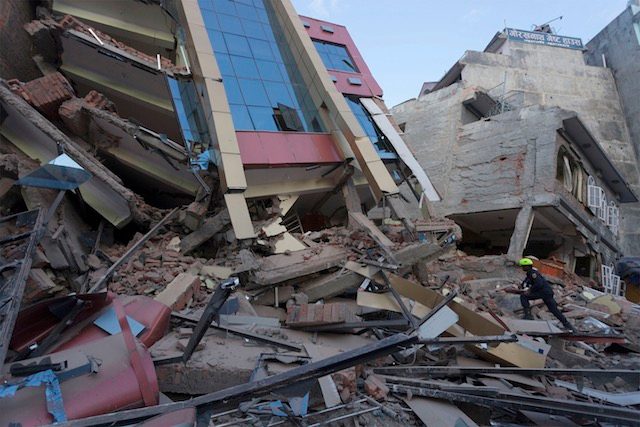SUMMARY
This is AI generated summarization, which may have errors. For context, always refer to the full article.

KATHMANDU, Nepal – Rescuers battled Wednesday, May 13, to reach survivors of a deadly new earthquake in Nepal that triggered landslides and brought down buildings, as the search resumed for a US military helicopter that went missing while delivering aid.
Thousands of traumatized survivors spent the night outdoors, afraid to return to their houses after the 7.3-magnitude quake, which killed dozens of people and hit less than 3 weeks after the country was devastated by its deadliest quake in more than 80 years.
The latest disaster took the overall death toll to more than 8,200 people, and has compounded the already monumental challenge of reaching far-flung mountain communities in desperate need of shelter, food and clean water.
The Nepal army resumed its aerial search for a US Marine Corps helicopter that went missing during a disaster relief operation in eastern Nepal, near where the latest quake hit.
The Pentagon has said there may have been a problem with fuel on the chopper, which was carrying 6 US Marines and two Nepal army soldiers when it disappeared.
“We have been informed that an American helicopter has gone missing, search operations have begun,” said Laxmi Prasad Dhakal, spokesman for the Nepal home ministry.
Dhakal said 65 people had been confirmed dead so far in the latest quake, which was centered 76 kilometers (47 miles) east of Kathmandu, and also killed 17 people in northern India.
“We had been focusing on relief distribution, but from yesterday our resources were deployed for rescue operations again,” he said.
Tuesday’s quake was felt as far away as New Delhi, and caused buildings to collapse in Tibet in neighboring China, killing at least one person there.
A second tremor of 6.3-magnitude struck Nepal around half an hour later, followed by yet more aftershocks, according to the USGS.
Large-scale casualties
Two large buildings damaged in the 7.8-magnitude quake that hit on April 25 collapsed in Kathmandu Tuesday. But Dolakha and Sindhupalchowk, two of the districts worst affected by the original quake, bore the brunt of the damage caused by the fresh tremors.
“Many houses have collapsed in Dolakha… there is a chance that the number of dead from the district will go up,” said Home Minister Bam Dev Gautam.
The Red Cross said it had received reports of large-scale casualties in the town of Chautara in Sindhupalchowk, where its Norwegian branch is running a field hospital.
“Hundreds of people are pouring in. They are treating dozens for injuries and they have performed more than a dozen surgeries,” said spokeswoman Nichola Jones.
There were several reports of landslides in the worst-hit areas, making the task of getting relief to remote communities in the mountainous country even more difficult.
Save the Children said the Gorkha region, near the epicenter of the April 25 quake, had also been hit by landslides and many key roads were blocked.
Regine Kopplow, a German aid worker who was in the Dolakha district headquarters of Charikot when the latest quake hit, saw huge dust clouds rise into the air as buildings collapsed.
“I saw a woman in the building opposite jump from the third floor who suffered injuries to her leg, elbow and hand,” said Kopplow, who works for Concern Worldwide.
“People stayed outside, the shaking continued. Some people were crying, hugging each other and sitting on the ground supporting each other.”
Back to tents
Many in Kathmandu had begun to return to their homes after weeks sleeping outdoors, but after Tuesday’s (May 12) strong tremors large numbers once again fled buildings to spend the night in tents or under tarpaulins.
The Nepalese government has acknowledged that it was overwhelmed by the scale of the April 25 disaster, which destroyed nearly 300,000 homes and left many more too dangerous to live in.
“At an hour of a natural disaster like this, we have to face it with courage and patience,” Nepal’s Prime Minister Sushil Koirala said after an emergency meeting of his cabinet on Tuesday.
Scientists said Tuesday’s quake was part of a chain reaction set off by the larger one that struck on April 25 in Lamjung district west of Kathmandu.
“Large earthquakes are often followed by other quakes, sometimes as large as the initial one,” said Carmen Solana, a volcanologist at Britain’s University of Portsmouth.
“This is because the movement produced by the first quake adds extra stress on other faults and destabilizes them,” she told the London-based Science Media Centre. – Paavan Mathema, AFP / Rappler.com
Add a comment
How does this make you feel?
There are no comments yet. Add your comment to start the conversation.